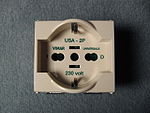AC power plugs and sockets
AC power plugs and sockets are devices that allow electrically operated devices to be connected to the primary alternating current (AC) power supply in a building. Electrical plugs and sockets differ in voltage and current rating, shape, size and type of connectors. The types used in each country are set by national standards.[1]
Generally the plug is the movable connector attached to an electrically operated device's mains cable, and the socket is fixed on equipment or a building structure. Plugs have male circuit contacts, while sockets have female contacts. The plug has protruding prongs, blades, or pins that fit into matching slots or holes in the socket. A socket is also called a receptacle, outlet, or power point (British English).[2][3] It may be surrounded by a cover called a wall plate, face plate, outlet cover,[4] socket cover, or wall cover.
To reduce the risk of electric shock, plug and socket systems can incorporate safety features. These may include socket design intended to accept only compatible plugs inserted in the correct orientation; plugs with insulated sleeves on contact pin shanks so a partially inserted plug does not bear exposed live pins that could be touched; or sockets with blocking shutters that open only when a compatible plug is inserted. Sockets are designed to prevent exposure of bare live contacts. The exposed contacts present in some sockets are used exclusively for earthing (grounding).
History
Early history

When electricity was first introduced into houses, it was primarily used for lighting. At that time, many electricity companies operated a split-tariff system where the cost of electricity for lighting was lower than that for other purposes. This led to portable appliances (such as vacuum cleaners, electric fans, and hair driers) being connected to light bulb sockets.
As electricity became a common method of operating labour-saving appliances, a safe means of connection to the electric system other than using a light socket was needed. The original two-pin electrical plug and socket was invented by Harvey Hubbell and patented in 1904. Hubbell's first design screwed into a light socket rather than being directly connected to the building's fixed wiring. (US Patent #774,250) Other manufacturers adopted the Hubbell pattern and by 1915 they were widespread, though light-socket connections for appliances persisted into the 1920s.[5][6][7]
The grounded consumer plug has several claimants to its invention. The earliest patent application for a grounded plug appears to be 11 January 1915 by George P. Knapp, on behalf of the Harvey Hubbell company.[8] This patent covers the use of a grounding pin which extends further than the other two contacts to ensure that it is engaged first. The configuration of the socket was not operable with existing two-contact ungrounded plugs. Other grounded sockets that are widely used today are operable with ungrounded plugs.
The German Schuko-system plug was patented by Albert Büttner in 1926.[9] The current American version of the grounded plug, with two vertical blades and a round grounding pin was invented by Philip F. Labre, while he was attending the Milwaukee School of Engineering. It is said that his landlady had a cat which would knock over her fan when it came in the window. When she plugged the fan back in, she would get an electric shock. Labre deduced that if the plug were grounded, the electricity would go to earth through the plug rather than through the person holding it. He applied for a patent on 12 May 1927,[10] and was issued a US patent for grounding receptacle and plug in June 1928.[10] As the need for safer installations became apparent, earthed three-contact systems were made mandatory in most industrial countries.
Proliferation
During the first fifty years of commercial use of electric power, standards developed rapidly based on growing experience. Technical, safety, and economic factors influenced the development of all wiring devices and numerous varieties were invented. Gradually the desire for trade eliminated some standards that had been used in only a few countries.
Former colonies may retain the standards of the colonising country. Sometimes offshore industrial plants or overseas military bases use the wiring practices of their controlling country instead of the surrounding region.
Some countries have multiple voltages, frequencies and plug designs in use, which can create inconvenience and safety hazards. Hotels and airports may maintain receptacles of foreign standards for the convenience of travellers.
Consolidation
Many countries have settled on a few de facto standards, which became formalised as official national standards. Older installations of obsolete wiring exist, since some buildings have wiring that pre-dates modern standards.
In Europe, since 1965 the International Commission on the Rules for the Approval of Electrical Equipment (CEE) has published a standard (CEE 7 Specification for Plugs and Socket-Outlets for Domestic and Similar Purposes[11]) describing the plugs and sockets used. In North America the National Electrical Manufacturers' Association publishes standards for plugs and sockets.
There has been some movement towards consolidation of standards for international interoperability. For example, the CEE 7/7 plug has been adopted in several European countries and is compatible with both CEE 7/5 and CEE 7/4 sockets, while the ungrounded and unpolarised Europlug is compatible with an even greater proportion of European and other socket types. IEC 60906-1 has been proposed as a common standard for all 230 V plugs and sockets worldwide but has only been adopted in Brazil so far. IEC 60906-2 recognizes the wide use of the NEMA 5-15 parallel blade plug and socket and recommends it for all 120 V applications.
Manufacturers of some electrical devices, such as personal computers, fit an IEC 60320 inlet on the device, and supply for each country a power cord with an IEC 60320 coupler on one end and a national power plug at the other. Such devices are designed to adapt to a wide range of voltage and frequency standards. This reduces the testing required for approval, and reduces the number of product variations that must be made to serve world markets.
Application issues
Design features of plugs and sockets have gradually developed to reduce the risk of electric shock and fire. Safety measures may include pin and slot dimensions and layout that permit only proper insertion of plug into socket, and earth pins longer than power pins so the device becomes earthed before power is connected. Electrical insulation of the pin shanks was added to some designs, to reduce live contact exposure when a plug is partially inserted in a socket. Shutters that open only for the correct plug prevent foreign objects from contacting live slots. Some types include fuses and switches.
Grounding/earthing
A third contact may be provided for a connection to earth ground, intended to protect against insulation failure of the connected device. Grounding sockets have three holes, to use with either 3-pin earthed or 2-pin non-earthed plugs. When grounded distribution systems became common, earlier ungrounded socket types were either replaced with new standards, or revised to include a grounding pin.
Different types of plugs are used for different IEC appliance classes. The assigned class depends on whether or not the device is earthed, and the degree of insulation it incorporates. Class I, for example, refers to earthed equipment which requires a third contact in the plug and socket, while Class II refers to unearthed equipment protected by double insulation.
Polarization
Some wiring systems have two circuit conductors, both of which have a significant potential with respect to earth. Where the wiring system defines a "neutral" conductor that is connected to earth, it is an advantage for appliance designers to maintain that distinction. This requires a plug that can only be connected in one way to the wall socket, so that the energised and neutral conductors are not interchanged. Such "polarized" plugs are not interchangeable with non-polarized receptacles.
Polarization is maintained by the shape, size, or position of plug pins and socket holes to ensure that a plug fits only one way into a socket. The (single pole) switch of the appliance is then connected in series with the energized wire. For an appliance such as a toaster, putting the exposed heating wires on the neutral side of the switch provides a small measure of extra protection against electrical shock; similarly, lamps with Edison screw bases will connect the screw shell of the lamp socket to the neutral conductor.
Interchange hazards
Plugs and sockets are designed as a system to meet standards for safety and reliability. Some types of receptacle may accept more than one type of plug; where this is an official, approved intention of the receptacle design, all the approved combinations will be tested to the applicable safety standards. Occasionally, plug and receptacle combinations may allow power to flow but may not meet product standards for mating force, grounding, current capacity, life expectancy, or safety. Improvised or user-modified connectors will not meet the product safety standards. Adapters between different standards can overcome mechanical incompatibility.
Special purpose plugs and sockets
Special purpose sockets may be found in residential, industrial, commercial or institutional buildings. Examples of systems using special purpose sockets include:
- "Clean" (low electrical noise) ground for use with computer systems,
- Emergency power supply,
- Uninterruptible power supply for critical or life-support equipment,
- Isolated power for medical instruments,
- "Balanced" or "technical" power used in audio and video production studios,
- Theatrical lighting,
- Outlets for electric clothes dryers, electric ovens, and air conditioners with higher current rating.
Special-purpose sockets may be only labelled or coloured to identify a reserved use of a system, or may be physically incompatible with general purpose plugs (keyed or with special shapes of pins), to prevent use of unintended equipment.
Types in present use


There are two basic standards for voltage and frequency in the world. One is the North American standard of 120 volts at a frequency of 60 Hz, and the other is the European standard of 220–240 volts at 50 Hz. The differences arose for historical reasons as discussed in the article mains electricity. Usually NEMA type receptacles and plugs are used on 60 Hz systems, and CEE and other types are used on 50 Hz systems, but exceptions exist. The outline maps show the different plug types, voltages and frequencies used around the world,[12] colour-coded for easy reference.
Socket types are sometimes designated by an arbitrary letter designation from a 1998 US government publication,[12] which has no official standing but is sometimes useful as a de facto naming standard when comparing different AC power plugs and sockets.
In Europe, the European Committee for Electrotechnical Standardization (CENELEC) publishes a list of approved plug and socket standards used in the member countries.[13]
Argentina IRAM 2073 (Argentinian 10 A/250 V) and compatible types
The Argentinian plug is a three-wire earthed plug rated at 10 A (or 20A), 250 V defined by IRAM and used in Class 1 applications in Argentina. This plug is similar in appearance to the Australasian and Chinese plugs. The pin length is same as the Chinese version. The most important difference from the Australian plug is that the Argentinian plug is wired with the live and neutral contacts reversed.
In Brazil, this kind of plug is still commonly found in high-power appliances like air conditioners, dishwashers, and household ovens.[citation needed] Since the adopted IEC 60906-1 standard prescribes a high-current plug version, the original motivation to use the "Argentinian" plug has ceased to exist.[citation needed]
Australian standard AS/NZS 3112 (Australasian 10 A/240 V)


The plug used in Australia, New Zealand, Fiji, Tonga, Argentina, Solomon Islands, Papua New Guinea and China has a grounding pin and two flat current-carrying pins forming an upside down V-shape.[14] The flat blades measure 6.5 by 1.6 mm (0.256 by 0.063 in) and are set at 30° to the vertical at a nominal pitch of 13.7 mm (0.539 in). Australian and New Zealand wall sockets almost always have switches on them for extra safety, as in the UK. An unearthed version of this plug with two angled power pins but no earthing pin is used with small double-insulated appliances, but the powerpoint (wall) outlets always have three pins, including a ground pin.
There are several AS/NZS 3112 plug variants,[15] including ones with larger or differently shaped pins used for devices drawing 15, 20, 25 and 32 A. These sockets accept plugs of equal or of a lower current capacity, but not of higher capacity. For example, a 10 A plug will fit all sockets but a 20 A plug will fit only 20, 25 and 32 A outlets.
Australia's standard plug/socket system was originally codified as standard C112 (floated provisionally in 1937, and adopted as a formal standard in 1938), which was superseded by AS 3112 in 1990. As of 2005, the latest major update was AS/NZS 3112:2004, which mandated insulated pins[16] by 2005 at the point of sale in all Australian States and New Zealand. Equipment and cords made before 2003 can still be used.
British and compatible standards
5 ampere

India, Sri Lanka, Nepal and Pakistan have standardised on a plug which was originally defined in British standard BS 546. It has three large round pins in a triangular pattern. The BS 546 standard is also used in parts of the Middle East (Kuwait, Qatar) and parts of Asia and South East Asia that were electrified by the British. This type was also previously used in South Africa, but has been phased out in favour of the 15 A version there. In Ghana, Kenya and Nigeria, the plug has been mostly replaced by the British BS 1363. This 5 A plug, along with its smaller 2 A version, is sometimes used in the UK for centrally switched domestic lighting circuits, to distinguish them from normal power circuits.
15 ampere

The 15 A version of the BS 546 plug has larger live and neutral pins of 7.05 mm (0.278 in) diameter and 21.1 mm (0.831 in) length. Live and neutral are spaced 1 in (25.4 mm) apart, and earth is 1+1⁄8 in (28.58 mm) away from each of them. In India, Pakistan, Sri Lanka, Nepal and Namibia, the 15 A version is used for larger appliances. Some countries such as South Africa use it as the main domestic plug and socket, where sockets always have an on–off switch built into them. South African standard SANS 164 defines a modernized plug derived from BS 546, and also defines keyed variants for special purposes such as telecommunications power. The BS 546 plug and socket is still commonly found in Botswana, alongside BS 1363. BS 546 was almost universally used in the UK and Ireland for indoor dimmable theatre and architectural lighting installations, but there is now a widespread move to using CEE 16 A industrial sockets in new installations[citation needed]. It was also often used for non-dimmed but centrally controlled sockets within such installations, or where an unfused plug was desired. This plug is also widely used in Israel, Singapore, Sri Lanka and Malaysia for air conditioners and clothes dryers.
A socket has been developed for the Indian subcontinent that accepts both 5 A and 15 A BS 546 plugs, with adjacent holes of the appropriate gauge.
BS 1363
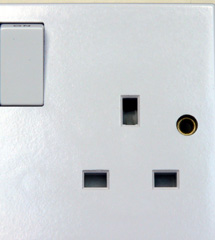
The British Standards 1363 plug[17] is used in the United Kingdom, the Republic of Ireland, Hong Kong, Cyprus and other countries. Compatible plugs standards are IS 401 and IS 411 (Ireland), MS 589 (Malaysia), SS 145 (Singapore), and SASO 2203 (Saudi Arabia).
This large plug, commonly called a 13 A plug, has three rectangular pins forming a triangle. Live and neutral are 17.4 mm (0.685 in) long, and spaced 22.2 mm (0.874 in) apart. 9 mm (0.354 in) of insulation at the trailing ends of the pins prevents accidental contact with a bare connector while the plug is partially inserted. The earth pin is approximately 3.97 by 7.92 mm (0.156 by 0.312 in) and 22.2 mm (0.874 in) long.
The plug has a 1 in (25.40 mm) long fuse to protect the appliance flexible cable from overload. British wiring standards allow up to 32 A ring main circuits, so circuit protection of the fixed wiring cannot protect relatively small flexible cable conductors. Plugs and sockets are wired so that the fuse opens the live wire. The same convention is used for all British sockets connected directly to "mains" wiring.
UK wiring regulations (BS 7671) require sockets in homes to have shutters over the live and neutral connections to prevent the insertion of objects other than electric plugs. On Class II appliances, the earth pin is often plastic and serves only to open the shutters and to enforce the correct orientation of live and neutral pins. Opening the shutters with a screwdriver to insert other plugs may be dangerous if the plugs do not have a fuse or do not fit properly.
BS 1363 plugs and sockets started appearing in 1946 and BS 1363 was first published in 1947. By the end of the 1950s, it had replaced the earlier BS 546 in new installations, and by the end of the 1960s, most earlier installations had been rewired to BS 1363 standards. Sockets usually include switches on the live side for convenience and safety.
BS 4573 (UK shaver)

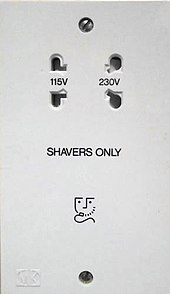
In the United Kingdom and Ireland, there is a two-pin plug and socket for use with electric shavers in bath or shower rooms.[18] Electric toothbrushes in the UK are normally supplied with the same plug. It has 0.2 in (5.08 mm) diameter pins 0.625 in (15.88 mm) long and 0.656 in (16.66 mm) apart. The sockets for this plug are often designed to accept unearthed CEE 7/16, US or Australian plugs as well. Sockets are often able to supply either 230 V or 115 V. In wet zones, they must contain an isolation transformer compliant with BS 3535.
Europlug compatible standards
A number of standards based on two round pins and compatible with the CEE 7/16 Europlug are in use in continental Europe and elsewhere.
CEE 7/4 (German "Schuko" 16 A/250 V grounded)

CEE 7/4, commonly called "Schuko" socket, has a recessed round shape with two symmetrical round receptacles and two grounding clips on the sides of the socket. The Schuko connection system is symmetrical and unpolarised by design, allowing live and neutral to be reversed. Its dimensions are compatible with CEE 7/5 (French plug/socket) except that the female ground contact is omitted. The socket also accepts Europlugs and CEE 7/17 plugs. It supplies up to 16 A. It is used in Albania, Austria, Bosnia and Herzegovina, Bulgaria, Chile, Croatia, Denmark, Estonia, Finland, Germany, Greece, Hungary, Iceland, Indonesia, Iran, Italy, Latvia, Lithuania, Luxembourg, Republic of Macedonia, the Netherlands, Norway, Pakistan, Portugal, Romania, Russia,[19] Serbia, Slovenia, South Korea, Spain, Sweden, Turkey, Ukraine, and Uruguay.
It is also defined as the Class I plug in Italian standard CEI 23-5. (CEE 7/17 is defined as the class II plug in CEI 23-5.)
"Schuko" is an abbreviation for the German word Schutzkontakt, which means "Protective (that is, grounded) contact".
Some countries, including Finland, Denmark,[20] Norway and Sweden, require child-proof outlet shutters;the German Schuko standard does not have this requirement.
CEE 7/5 (French)
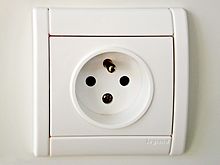

France, Belgium, Poland, the Czech Republic, Slovakia and some other countries have standardized on a round plug with two round pins measuring 4.8 by 19 mm (0.189 by 0.748 in), spaced 19 mm (0.748 in) apart and with a hole for the socket's ground pin. This standard will also accept Europlugs and CEE 7/17 plugs. Although the plug is polarised, there is no universally observed standard for placement of the live and neutral. However, at least the Czech norm requires the live wire to be on the left side when facing the wall socket.
CEE 7/5 plugs are not compatible with the CEE 7/4 socket because earthing in the CEE 7/5 socket is via a round male pin permanently mounted in the socket.
CEE 7/7 plug

To bridge the differences between German and French standards, the CEE 7/7 plug was developed. It is polarised to prevent the live and neutral connections from being reversed when used with a French CEE 7/5 outlet, but allows polarity reversal when inserted into a German CEE 7/4 socket. The plug is rated at 16 A.
It has grounding clips on both sides to connect with the CEE 7/4 socket and a female contact to accept the grounding pin of the CEE 7/5 socket. It is used in almost all European countries. Currently, appliances are sold with non-rewireable CEE 7/7 plugs attached. This means that the plugs are now identical between countries like France and Germany, but the sockets are different.
CEE 7/16 Europlug

This two-pin plug is popularly known as the Europlug. The plug is ungrounded and has two round 4 mm (0.157 in) pins, which usually converge slightly towards their free ends. It is described in CEE 7/16[21] and is also defined in Italian standard CEI 23-5 and Russian standard GOST 7396 C5. This plug is intended for use with devices that require 2.5 A or less. Because it is unpolarised, it can be inserted in either direction into the socket, so live and neutral are connected arbitrarily. The separation and length of the pins allow its safe insertion in most CEE 7/5, CEE 7/4 "Schuko", Israeli, CEE 7/7, Swiss, Danish and Italian outlets, as well as BS 4573 UK shaver sockets. It can be forced into BS 546 (5 A) and some BS 1363 sockets if the shutters are manually opened, though the connection may be unreliable and unsafe[clarification needed][citation needed].
The Europlug itself is used in class II applications throughout continental Europe. It is also used in the Middle East (Iran), most African nations, South America (Brazil, Chile, Argentina, Peru and Bolivia), Asia (India, Bangladesh, Sri Lanka, Indonesia, Pakistan, and South Korea) as well as Russia and the former Soviet republics, such as Ukraine, Armenia, Georgia, and many developing nations. It is also used alongside the BS 1363 in many nations, particularly former British colonies.
CEE 7/17 (German/French 16 A/250 V ungrounded)

This plug also has two round pins but the pins are 4.8 mm (0.189 in) in diameter like CEE 7/5 and CEE 7/4 and the plug has a round plastic or rubber base that stops it being inserted into small sockets intended for the Europlug. Instead, it fits only into large round sockets intended for CEE 7/5 and CEE 7/4. The base has holes in it to accommodate both side contacts and socket earth pins. It is used for large appliances, and in South Korea for all domestic non-earthed appliances. It is also defined as the Class II plug in Italian standard CEI 23-5; the Schuko is defined as the class I plug in CEI 23-5. It can also be inserted in to Israeli SI 32 with some difficulty.
Unearthed sockets
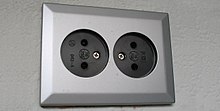
Round unearthed sockets have no ground provisions and consequently have been phased out in most countries. (In Sweden they were banned from new installations in 1994, but existing installations may be used as long as they are in good shape). In some countries there is generally a ban for using this kind of socket in the same room/area as any grounded outlet as the safety concept of these outlets is that there shouldn't be anything grounded thus reducing the risk of electric shock by touching something that has become live and touching ground at the same time (so called "insulated room"). For example, in Germany, ungrounded outlets are rare, found only in very old installations, whereas the Netherlands they are common in "dry areas" such as in bedrooms or living rooms. Standards also vary between countries as to whether child-resistant shutters are required. The depth of the sockets also vary between countries and age. Older sockets are so shallow that it's possible to touch the pins of a plug when the plug is inserted deep enough to get electrical power on the pins, while newer sockets are deep enough to protect from this kind of accident. Depending on the country and the age of the socket these sockets may have 4.0 or 4.8 mm receptacles. (4.0mm are usually similar to 6A GOST 7396 type C1 and 4.8mm are usually simiar to 16A GOST 7396 type C1, but for example in Sweden older 4.8mm sockets are usually marked 10A or 10/16A stating that at the time no more than 10A were alloved). The latter accept CEE 7/5 and CEE 7/4 plugs in addition to Europlugs, though without ground connection. Countries using the CEE 7/5 and CEE 7/4 standards vary in whether ungrounded round sockets are still permitted in environments where the need for grounding is less critical. Adaptors and trailing sockets and power strips designed to accept only Europlugs with 4 mm (0.157 in) pins may also have plastic barriers in place to prevent CEE 7/17, Schuko or French plugs from entering. Note that round ungrounded sockets and plugs are for class 0 insulation and not a kind of europlug. The grounded CEE 7/5 and CEE 7/4 sockets are specifically designed to not allow insertion of an ungrounded round plug. Europlugs are in contrast for class II insulation and designed specifically to plug in CEE 7/5 and CEE 7/4 sockets (aswell as round ungrounded sockets, both 4.0 and 4.8mm types and some other sockets including the rare europlug sockets).
Danish Section 107-2-D1 (10/13/16 A/250 V earthed)


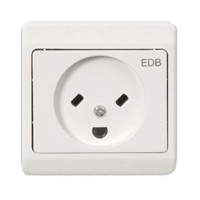
This Danish standard plug is described in the Danish Plug Equipment Section 107-2-D1 Standard sheet (SRAF1962/DB 16/87 DN10A-R). Unlike the French CEE 7/5 plug, the earthing pin is on the plug, not in the socket. The Danish socket need not be recessed to protect the earthing pin. The Danish standard provides for outlets to have child-resistant shutters.
The Danish socket will also accept the CEE 7/16 Europlug or CEE 7/17 Schuko-French hybrid plug. CEE 7/4 (Schuko), CEE 7/7 (Schuko-French hybrid), and grounded CEE 7/5 French plugs will also fit into the socket but should not be used for appliances that need earth contact. The current rating on both plugs is 13 A.
A variation (standard DK 2-5a) of the Danish plug is for use only on surge protected computer outlets. It fits into the corresponding computer socket and the normal socket, but normal plugs deliberately don't fit into the special computer socket. The plug is often used in companies, but rarely in private homes.
There is a variation for hospital equipment with a rectangular left pin, it is used for life support equipment.
Traditionally all Danish sockets were equipped with a switch to prevent touching live pins when connecting/disconnecting the plug. Today, sockets without switch are allowed, but then it is a requirement that the sockets have a cavity to prevent touching the live pins. The shape of the plugs generally makes it difficult to touch the pins when connecting/disconnecting.
Since the early 1990s grounded outlets have been required in all new electric installations in Denmark. Older outlets need not be grounded, but all outlets, including old installations, must be protected by ground-fault interrupters (HFI or HPFI in Danish) by 1 July 2008.
As of 1 July 2008, wall outlets for French 2-pin, female earth CEE 7/5 are permitted for installations in Denmark.[22] This was done because no electrical equipment sold to private users is equipped with a Danish plug.
Sockets for the Schuko were not permitted until 15 November 2011. It could also result in a bad connection of the pins, with resultant risk of overheating and fire. Many international travel adapter sets sold outside Denmark match CEE 7/16 (Europlug) and CEE 7/7 (Schuko-French hybrid) plugs which can readily be used in Denmark.
Denmark has allowed CEE 7/4 "Schuko" sockets from 15 November 2011.[23]
Italy CEI 23-16/VII
The Italian earthed plug/socket standard, CEI 23-16/VII, includes two models rated at 10 A and 16 A that differ in contact diameter and spacing (see below for details). Both are symmetrical, allowing the live and neutral contacts to be inserted in either direction. The 10 A plug is called IT1-10P or S11 and the socket is IT1-16R or P11. The 16 A plug is called IT2-16P or S17 and the socket is IT2-16R or P17.
The 10 A style extends CEE 7/16 by adding a central earthing pin of the same gauge. Thus, CEI 23-16-VII 10A sockets can accept CEE 7/16 Europlugs. This is the plug shown in the first picture.
The 16 A style looks like a magnified version of the 10A style, identical in shape. The pins are 5 millimetres thick (being 4 mm thick in 10 A type), 26 mm apart (while 19 mm apart in 10 A type) and 7 mm longer. The packaging of these plugs in Italy may claim they are a "North European" type. In the past they were also referred to as per la forza motrice[24] (for electromotive force, see above) or sometimes industriale (industrial), although the latter has never been a correct definition as factories used preminently three-phase current and specialized connectors. Big appliances are usually sold with schuko plugs, so 16 Ampere non-rewirable plugs are only used in adapters and power cords. Those appliances are always grounded, so unearthed 16A plugs are now very uncommon, and only a few brands still sold them in rewirable version.
The double standard was initially adopted because in Italy, up to the second half of the 20th century, the electric power used for lamps and the one used for all other appliances were sold at different tariffs, charged with different taxes, accounted with separated electricity meters, and sent on different wire lines that ended with different sockets.[25] Even though the two electric lines (and respective tariffs) were officially unified during the summer of 1974[26] many houses kept twin wires and twin electricity meters for years thereafter (in some zones of Lazio the 127V network was provided for lighting until 1999). The two gauges for plugs and sockets thus became a de facto standard which is still in use today and has been standardized with CEI 23-16/VII. Older installations often have sockets that are limited to either the 10A or the 16A style plug, requiring the use of an adapter if the other gauge needs to be connected.
CEE 7/16 unearthed Europlugs are also in common use; they are standardized in Italy as CEI 23-5 and fit most of the appliances with low current requirement and double insulation.
Appliances with CEE 7/7 Schuko-French plugs are often sold in Italy too; however most sockets will not accept them since the pins of the CEE 7/7 Schuko-French plugs are thicker than the Italian ones. Adapters are cheap and commonly used to connect CEE 7/7 plugs to CEI 23-16/VII sockets, but they cannot exceed 1500 Watts and they could make an unsafe connection in some cases.
The current Italian standards provide for outlets to have child-resistant shutters (“Sicury” patent [27])
Italian multiple standard sockets
Given that the plug with which appliances are fitted and sold varies, in modern installations in Italy (and in other countries where CEI 23-16/VII plugs are used) it is usual to find sockets that can accept more than one standard.
The simpler type has a central round hole and two 8-shaped holes above and below. This design allows the connection of both styles of CEI 23-16/VII plugs (10 and 16 A) and the CEE 7/16 Europlug. The advantage of this socket style is its small, compact face. VIMAR brand claims to have patented this socket first in 1975[28] with their Bpresa™ model; however soon other brands started selling similar products, mostly naming them with the generic term presa bipasso (twin-gauge socket) that is now of common use.
A second, quite common type looks like a CEE 7/4 (German) socket, but adds a central grounding hole. This design can accept CEE 7/4 (German), CEE 7/7 (German/French), and CEI 23-16/VII Italian 10 A plugs. Some of these sockets may also have 8-shaped holes to accept CEI 23-16/VII Italian 16 A plugs as well. Its drawback is that it’s twice as large as a normal CEI 23-16/VII italian socket.
Other types may push compatibility even further. The VIMAR-brand universale (all purpose) socket, for example, accepts CEE 7/4 (German), CEE 7/7 (German/French), both CEI 23-16/VII italian 10 and 16 A plugs, and also NEMA 1-15 (USA/Japan) plugs.
Soviet standard GOST 7396 C 1 (6 A or 16 A /250 V ungrounded)
This Soviet plug, still widely used in modern Russia, has pin dimensions and spacing equal to the Europlug, but lacks the insulation sleeves. Unlike the Europlug, it is rated 6 A. It has a round body like the French CEE 7/5 or flat body with a round base like CEE 7/17. The round base has no notches. The pins are parallel and do not converge. The body is made of fire resistant thermoset plastic. The corresponding 6 A socket accepts the Europlug, but not others as the 4.5 holes are too small to accept the 4.8 mm pins of CEE 7/4, CEE 7/5 or CEE 7/7 plugs. Until 1970s very similar plugs and sockets were used in almost all European countries.
There were also moulded rubber plugs available for devices up to 16 A similar to CEE 7/17, but with a round base without any notches. They could be altered to fit a CEE 7/5 or CEE 7/4 socket by cutting notches with a sharp knife.
-
Soviet grip plug, 6 A 250 V AC, thermoset plastic
-
Soviet round plug, 6 A 250 V AC, thermoset plastic, half height
-
Moulded rubber soviet plugs cut with knife in attempt to be similar to CEE 7/16 (left) and CEE 7/17 (right). Originally the plugs had a round base.
-
Soviet shaver power cord. The plug is similar to CEE7/16, but has different configuration. Thermoplastic plug is rated 6 A and 250 V.
Swiss SEV 1011 (Swiss 10 A/250 V)
Switzerland has its own standard which is described in SEV 1011 (ASE1011/1959 SW10A-R).[29] This plug is similar to the Europlug (CEE 7/16), except that it has an offset earth pin and the pin shanks are not necessarily insulated (the pins of most modern appliances are), so plugs partially inserted into non-recessed sockets present a shock hazard. Sockets used in kitchens, bathrooms and other wet areas are recessed, while those used elsewhere are not (after 2015, only recessed sockets are allowed to be installed in any setting, minimizing the risk of electric shocks). Some plugs and adaptors have a tapered form and can be used in either environment, while others will fit only the non-recessed sockets. Swiss sockets accept Swiss plugs or Europlugs (CEE 7/16). There is also a non-earthed two-pin variant with the same pin shape, size, and spacing as the SEV 1011's live and neutral pins, but with a more flattened hexagonal form. It fits into Swiss sockets and CEE 7/16 sockets, and is rated 10 A.
The SEV 1011 earth pin is offset by 5mm[30] from the centre line of the live and neutral pins.
The system is modular and allows variants with 5 pins for 3 phases and square pins for 16 A (and the combination of both – see reference). Above 16 A, equipment must either be hardwired to the electrical supply system with appropriate branch circuit protection, or connected to the mains with an appropriate high power industrial connector.
IEC 60906-1 (Brazilian NBR 14136)

In 1986, the International Electrotechnical Commission published IEC 60906-1, the specification for a plug that looks similar but is not identical to the Swiss plug. This plug was intended to one day become the common standard for all of Europe and other regions with 230 V mains, but the effort to adopt it as a European Union standard was put on hold in the mid 1990s.[31]
Brazil, which had been using mostly Class II Europlugs (while households also commonly presenting socket fittings for the NEMA 1–15 and NEMA 5–15 standards), set out IEC 60906-1 as the national standard in 2001 under specification NBR 14136.[32] This standard was never really enforced or encouraged in that country until 2007, when the adoption of IEC 60906-1 was made optional for manufacturers. It helped domestic consumers that most of Class II plugs fitted in the new IEC 60906-1 socket.
Since 1 January 2010, new electrical appliances in Brazil must comply with the new IEC 60906-1 requirement. End-user stores and resellers can sell equipment without adoption deadlines, but importers will no longer be allowed to bring in nonconforming devices, nor will manufacturers be able to sell them in Brazil.
There are two types of sockets and plugs in this system: one for 10 A, with a 4 mm pin diameter, and another for 20 A, with a 4.8 mm pin diameter, the latter used for heavier appliances such as microwave ovens.[33] The Brazilian IEC 60906-1 earth pin is offset by 3mm[30] from the centre line of the live and neutral pins.
South Africa has also introduced the IEC 60906-1 standard as SANS 164-2.[34][35]
IEC 60906-2 designated the NEMA 5-15 grounded 15 A socket and plug as the standard for 120 volt applications; it is a recognition that the NEMA parallel blade plug and socket is already in universal use in North America.
China CPCS-CCC (Chinese 10 A/250 V)

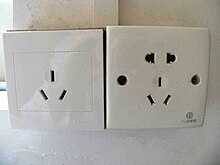
The standard for Chinese plugs and sockets is set out in GB 2099.1‐2008 and GB 1002‐2008. As part of China's commitment for entry into the WTO, the new CPCS (Compulsory Product Certification System) has been introduced, and compliant Chinese plugs have been awarded the CCC Mark by this system. The plug is three wire, earthed, rated at 10 A, 250 V and used for Class 1 applications; a 16 A version also exists. The Australian plug fits, though the pins on the Chinese plug are thinner and 1 mm (0.039 in) longer. China also uses American/Japanese NEMA 1‐15 sockets and plugs for Class-II appliances. The voltage at a Chinese socket of any type is 220.
Israel SI32
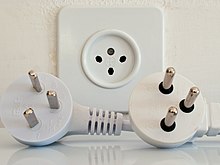
This plug, defined in SI 32 (IS16A-R), is unique to Israel. It has three flat pins to form a Y-shape. Live and neutral are spaced 19 mm (0.75 in) apart. The plug is rated at 16 A. In 1989, the standard was revised to use three round 4.5 mm (0.177 in) pins in the same locations, allowing the socket to accept the Europlugs used in Europe and Israel for non-earthed appliances. Sockets made since 1989 accept both flat and round pins for compatibility with both old and new plugs. Pre-1989 sockets which accept only old-style plugs are very rare in Israel.
This plug is also used in the areas controlled by the Palestinian National Authority: the West Bank and the Gaza Strip.
North American and IEC 60906-2
NEMA 1-15 (15 A/125 V ungrounded)

This plug and socket, with two flat parallel non-coplanar blades and slots, is used in most of North America and on the east coast of South America on lamps and double insulated small appliances that don't require a ground. It is standardized in the US by the National Electrical Manufacturers Association (NEMA)[36] Ungrounded NEMA 1-15 sockets have been prohibited in new construction in the United States and Canada since 1962, but remain in many older homes and are still sold for replacement. NEMA 1-15 plugs are still common because they are compatible with NEMA 5-15 (grounding) sockets.
Initially, both blades were the same width, so the plug could be inserted into the socket either way around. Plugs manufactured since the 1950s are polarized; the neutral blade is wider than the live blade, so the plug can be inserted only one way. Polarized NEMA 1-15 plugs will not fit into unpolarized sockets, which possess only narrow slots. NEMA 1-15 plugs will fit NEMA 5-15 grounded sockets, which have a wider slot for the neutral blade. Some devices that do not distinguish between neutral and live, such as internally isolated electronic power supplies, are still produced with unpolarized narrow blades.
Cheater plug adapters allow a grounding 5-15 plug to be fitted to a non-grounded 1-15 receptacle.
NEMA 5-15 (15 A/125 V grounded)
The NEMA 5-15 plug has two flat parallel blades like NEMA 1-15, but also adds a grounding blade.[36] It is rated 15 A at 125 volts. The ground pin is longer than the live and neutral blades, so the device is grounded before the power is connected. Both current-carrying blades on grounding plugs are narrow, since the ground pin enforces polarity. NEMA 1-15 plugs are also compatible with NEMA 5-15 sockets.
The 5-15 socket is standard in Canada, the United States, and Mexico. It is also used in Central America, the Caribbean, northern South America (Colombia, Ecuador, Venezuela and, as a legacy, part of Brazil), Japan, Taiwan, the Philippines and Saudi Arabia. This socket is recommended in IEC standard 60906-2 for 120 volt 60 Hz installations. Looking directly at a NEMA 5-15 outlet with the ground at the bottom, the neutral slot is on the left, and the live slot is on the right. Outlets may be installed in any orientation.
In some parts of the United States and all of Canada, tamper-resistant outlets are now required in new residential construction. These prevent contact by objects like keys or paper clips inserted into the receptacle.[37]
In stage lighting, this connector is sometimes known as PBG for Parallel Blade with Ground, Edison or Hubbell, the name of a common manufacturer.[citation needed]
NEMA 5-20 (North American 20 A/125 V grounded)
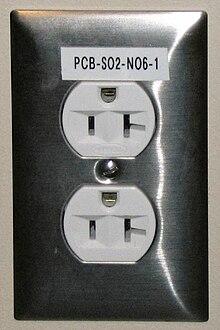
This is a 20 A receptacle. The NEMA 5-20 A variant has a T-slot for the neutral blade which accepts either 15 A parallel-blade plugs or 20 A plugs.
NEMA 14-30
A 30 A, 3 wire single-phase grounding receptacle is often used for electric clothes dryers. 240 volts from the split phase system is used for the heating elements, and the motor and controls run on 120 volts. These plugs have blades that are rather larger than NEMA 5-20, are more widely spaced, and are angled so as to prevent using the wrong plug in the wrong circuit.
NEMA 14-50
A 50 A 3 wire single-phase grounding outlet is usually installed in kitchens and used for electric cooking ranges and ovens. As for dryers, lighting and motors run on 120 V and the main heating element is connected for 240 V. Many plug-in electric cars use this type of outlet for recharging in the owner's garage.
JIS C 8303, Class II (Japanese 15 A/100 V ungrounded)
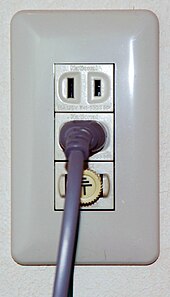
The Japanese plug and socket appear physically identical to NEMA 1-15. The Japanese system incorporates stricter dimensional requirements for the plug housing, different marking requirements, and mandatory testing and approval by METI or JIS.[38]
Older Japanese outlets and multi-plug adapters are unpolarized — the slots in the sockets are the same size — and will accept only unpolarized plugs. Japanese plugs generally fit into most North American outlets without modification, but polarized North American plugs may require adapters or replacement non-polarized plugs to connect to older Japanese outlets. In Japan the voltage is 100V, and the frequency is 50 Hz (East Japan) or 60 Hz (West Japan). Therefore, some North American devices which can be physically plugged into Japanese sockets may not function properly.
JIS C 8303, Class I (Japanese 15 A/100 V grounded)
Japan also uses a grounded plug similar to the North American NEMA 5-15.[38] However, it is less common than its NEMA 1-15 equivalent. Since 2005, new Japanese homes are required to have class I grounded outlets for connecting domestic appliances. This rule does not apply for the outlets not intended to be used for domestic appliances, but it is strongly advised to have class I outlets throughout the home.[39]
Thai 3 pin plug TIS 166-2549 (2006)

Thai Industrial Standard (TIS) 166-2547 and its subsequent update TIS 166-2549 stipulated a modification of the IEC 60906-1 plug, replacing prior standards which were based on NEMA 1-15 and 5-15, as Thailand uses 220 V electricity. The plug has two round power pins 4.8 mm in diameter and 19 mm in length, insulated for 10 mm and spaced 19 mm apart, with a grounding pin of the same diameter and 21.4 mm in length, located 11.89 mm from the line connecting the two power pins. It was designed to provide compatibility with prior hybrid three-pin sockets, which accept NEMA 1-15, NEMA 5-15 and Europlugs, all of which have been variably used in Thailand. The hybrid socket is also defined in TIS 166-2547, in addition to a plain three-round-pin socket, with plans to replace the former and phase out support for NEMA-compatible plugs. Sockets are polarised (as in NEMA 5-15).[40] The plug is similar to, but not interchangeable with, the Israeli SI32 plug.
Comparison of sockets
| Dept. of Commerce Type1 |
Socket standard | Power rating | Grounded | Polarised | Fused | Insulated pins |
|---|---|---|---|---|---|---|
| A | NEMA 1-15 unpolarised | 15 A/125 V | No | No | No | No |
| NEMA 1-15 polarised | 15 A/125 V | No | Yes | No | No | |
| JIS C 8303, Class II | 15 A/100 V | No | No | No | No | |
| B | NEMA 5-15 | 15 A/125 V | Yes* | Yes | No | No |
| NEMA 5-20 | 20 A/125 V | Yes* | Yes | No | No | |
| JIS C 8303, Class I | 15 A/100 V | Yes* | Yes | No | No | |
| C | CEE 7/16 (Europlug) | 2.5 A/250 V | No | No | No | Yes |
| CEE 7/17 | 16 A/250 V | No | No2 | No | No | |
| GOST 7396 C 1 | 6 A/250 V 16 A/250 V |
No | No | No | No | |
| BS 372 Part I | 2 A/250 V 5 A/250 V = BS 4573 |
No | No | No | No | |
| D | BS 546 (BS 372 Part II) | 2 A/250 V 5 A/250 V 15 A/250 V = SABS 164 30 A/250 V |
Yes | Yes | No | No |
| E | CEE 7/5 ‡ | 16 A/250 V | Yes* | Yes3 | No | No† |
| F | CEE 7/4 Schuko ‡ | 16 A/250 V | Yes* | No | No | No† |
| G | BS 1363, IS 401 & 411, MS 589, SS 145 | 13 A/250 V | Yes | Yes | Yes | Yes |
| H | SI 32 | 16 A/250 V | Yes4 | Yes | No | No |
| TIS 166-2549 | 16 A/250 V | Yes | Yes | No | Yes | |
| I | AS/NZS 3112 | 10 A/240 V 15 A/240 V 20 A/240 V 25 A/240 V 32 A/240 V |
Yes* | Yes | No | Yes |
| CPCS-CCC | 10 A/250 V | Yes | Yes | No | No | |
| IRAM 2073 | 10 A/250 V | Yes | Yes | No | No | |
| J | Swiss SEV 1011 | 10 A/250 V 16 A/250 V |
Yes* | Yes | No | No |
| K | Danish 107-2-D1 | 13 A/250 V | Yes* | Yes | No | No |
| L | CEI 23-16/VII | 10 A/250 V 16 A/250 V |
Yes* | No | No | Yes |
| − | IEC 60906-1 (2 pin) | 10 A and 20 A/250 V | No | No | No | Yes |
| IEC 60906-1 (3 pin) | 10 A and 20 A/250 V | Yes* | Yes | No | Yes |
- * Compatible with ungrounded plugs.
- † Deep-wall socket prevents human contact with pins.
- ‡ CEE 7/7 specifies a grounded hybrid plug that will fit into both the CEE 7/4 and CEE 7/5 sockets. CEE 7/17 specifies an ungrounded hybrid plug that will fit into both the CEE 7/4 and CEE 7/5 sockets.
- 1 Type letters are from a US Department of Commerce report[12] that sees widespread but not universal use to differentiate plug and socket types based on rough mechanical compatibility. Most common household plugs have an associated letter.
- 2 There are some CEE 7/17 plugs with special shape which are polarised when used with CEE 7/5 sockets (mechanically only).
- 3 Plug can only be inserted one way with French CEE 7/5, but lack of wiring convention means that the system is not polarized.
- 4 Newer sockets can accept ungrounded Europlugs.
Multi-standard sockets

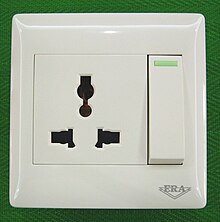
Sockets that take a variety of plug types can be found in various countries where market size or local market conditions make a specific plug standard impractical to implement. These sockets accept plugs fitting various European, Asian, North American and Australian standards. There is also a second multi socket type that accepts British type plugs as well, though these are a lot less common around the world. Since many plug standards are also associated with corresponding voltages, multi-standard sockets do not safeguard against devices being damaged by the wrong voltage. This forces users to be aware of the voltage requirements of their appliances as well as the prevailing local voltage. Some devices are compatible with a wide range of voltages and frequencies.
These sockets have one or more ground holes to allow 3-pin plugs. On properly wired circuits, the ground contact will be connected to earth ground. They may not provide grounding to all types of plugs, as is the case of Schuko or French plugs where the grounding pin that mates with the plug is part of the socket rather than the plug.
Adaptors
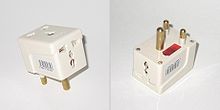
Adaptors allow travellers to use portable devices with foreign sockets. Adaptors allow physical connection between plug and socket but do not change voltage or frequency. A voltage converter is required for electrical compatibility in countries with a different voltage than the device is designed for, if it is not designed for variable voltage input.
Obsolete types
Old Spanish sockets
Some older industrial buildings in Spain used sockets that took a plug rated for higher current and had two flat contacts and a round ground pin, somewhat similar in design to the ones found on American plugs but larger in size. The two flat contacts are spaced further apart than on an American plug. No domestic appliances were ever sold with these plugs.
The live and neutral measure 9 by 2 mm (0.354 by 0.079 in), and are 30 mm (1.181 in) apart. All three pins are 19 mm (0.748 in) long, and the earth pin is a cylinder of 4.8 mm (0.189 in) diameter.
UK electric clock connector

Fused plugs and sockets of various proprietary and non-interchangeable types are found in older public buildings in the UK, where they are used to feed AC electric wall clocks. They are smaller than conventional socket outlets, commonly being made to fit BESA junction boxes, and are often of very low profile. Early types were available fused in both poles, later types fused in the live only and provided an earth pin. Most are equipped with a retaining screw or clip to prevent accidental disconnection. The prevalence of battery powered quartz controlled wall clocks has meant that this connector is rarely seen in new installations.
NEMA 1-15 style 5-receptacle outlet

This is a very rare 5-way outlet from c. 1928, and is able to accept modern ungrounded polarized NEMA 1-15 plugs because the outlet is polarized. The outlet is still obsolete as the NEMA standard only provides for having at most 3 outlets from a single wallplate.
American 240 V "Australian" style
The American electrical supply manufacturers Hubbell, Eagle, and possibly others made outlets and plugs that would match Australian plugs and sockets exactly. These American outlets date back to at least 1915 (as seen in US Patent 1,179,728 filed in 1915[41]), antedating the NEMA 5-15 sockets and plugs. They were meant for appliances requiring grounded 120 V, 15 A service, such as washing machines and gas dryers (to power the motor) for use in wet locations such as laundry rooms.
Split current/voltage ratings
Many older North American receptacles have two different current and voltage ratings, most commonly 10 A 250 V/15 A 125 V. This has to do with a peculiarity of the National Electrical Code from 1923 to the 1950s. Originally, receptacles were rated at 10 A 250 V, because the NEC limited lighting circuits to 10 A. In 1923, the code changed to allow lighting circuits to be fused at 15 A, but the previous 10 A rule still applied to circuits over 125 V.[42] The higher voltages were rarely used for lighting and appliances. Most receptacles with this rating are of the "T-slot" type.
US perpendicular outlet
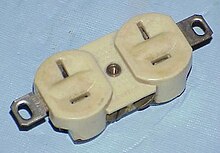

Another obsolete outlet, made by Bryant, 125 V 15 A and 250 V 10 A rating. A NEMA 5‐20 125 V 20 A or 6‐15 250 V 15 A plug with a missing ground pin would fit this outlet, but a NEMA 2‐20 plug is slightly too big to fit.
The upper slots as seen in the illustration connect to silver-colored wiring screws on the upper side, and the lower slots connect to brass-coloured wiring screws on the lower side.
In Australia, the same or similar T-configuration sockets are used for DC power outlets, such as in stand-alone power systems (SAPS), on boats and in police vehicles. Polarity is inconsistent.
In the former Soviet Union this socket was and still is commonly used for wiring in places where the voltage is lowered for safety purposes, like in schools, filling stations or in wet areas, and is rated 42 V 10 A AC. Such an unusual connection is intended specifically to make the connection of standard higher-voltage equipment impossible.
US Combination duplex outlet
The parallel and tandem outlet accepts normal parallel NEMA 1‐15 plugs and also tandem NEMA 2‐15 plugs. Both pair of receptacles are fed internally by the same supply.
A more recent and fairly common version of this type is the T-slot outlet, in which the locations of the tandem and the parallel slots were combined to create T-shaped slots. This version also accepts normal parallel NEMA 1‐15 plugs and also tandem NEMA 2‐15 plugs. Incidentally, a NEMA 5‐20 (125 V, 20 A), a NEMA 6-15 (250 V, 15 A) or 6‐20 (250 V, 20 A) plug with a missing ground pin would fit this outlet. This type is unavailable in retail shops since the 1960s.
UK Dorman & Smith (D&S)

The D&S plugs and sockets were rated at 13 A and were one of the early competing types for use on ring main circuits. They were never popular in private houses but were widely deployed in prefabricated houses and council housing. The BBC also used them. D&S supplied the sockets to local authorities at very low cost, with the intention of making money out of the sales of plugs typically priced at 4 times the price of a BS1363 plug. It is not known exactly when D&S ceased manufacturing the plugs and sockets but some local authorities continued to use them in new installations until the late 1950s. Many D&S sockets were still in use until the early 1980s, although the difficulty in obtaining plugs for them after around 1970 often forced their users to replace them with BS1363 sockets. The D&S plug suffered from a serious design fault: the live pin was a fuse which screwed into the plug body and tended to come unscrewed on its own in use. A fuse that worked loose could end up protruding from the socket, electrically live and posing a shock hazard, when the plug was removed.
UK Wylex Plug

The Wylex plugs and sockets were produced by Wylex Electrical Supplies Ltd. as a competitor to the BS1363 and D&S sockets for use on ring main circuits. The plugs were available in both 5 and 13 A versions, differing only by the widths of the live and neutral pins, and contained an internal fuse of the same rating as the plug. A plug had a central round earth pin and two flat pins, one on each side of the earth pin, for live and neutral. The two flat pins were slightly offset above and below the line cutting through the horizontal diameter of the earth pin. Wall sockets were rated at 13 A and took both 5 and 13 A plugs. There were also a 2 A version (with a different earth pin) and 15 A (not fused) variant, a special purposes plug (with a vertical neutral pin) also existed. Many 13 A plugs had a socket on the back which took a 5 A plug, but would not take another 13 A plug because the slots for the live and neutral pins were narrower than those of the wall sockets, resulting in a stacked arrangement. Wylex sockets were used in council housing and public sector buildings, and for a short while in private housing. They were particularly popular in the Manchester area although they were installed throughout England, mainly in schools, university accommodation, and government laboratories. Wylex plugs and sockets continued to be manufactured for several years after BS1363 sockets became standard and were commonly used by banks and in computer rooms during the 1960s and 1970s for uninterruptible power supplies or "clean" filtered mains supplies. It is not known exactly when Wylex ceased manufacturing its plugs and sockets; however plugs were available in electrical shops of the Manchester area until the mid 1980s.[43]
Lampholder plug

A lampholder plug fits into the bayonet cap or Edison screw socket of a lampholder in place of a light bulb and enables an electrical appliance to be powered from a wall or ceiling light fitting. They were commonly used during the 1920s to 1960s when wall sockets were scarce in many houses and often nonexistent in some of the rooms (bathrooms, cellars, attics, etc.). Also, as in some countries (like Italy) electricity was supplied on a "split tariff" basis with electricity for lighting being charged at a lower fare than that for other purposes, lampholder plugs enabled the consumers to reduce their electricity costs and were thus in broad use.
Lampholder plugs were and are rarely fused.
In the UK, lighting circuits are protected with a 5 A or 6 A fuse or circuit breaker.[44] Wiring regulations in the UK and some other countries no longer approve lampholder plugs because of the risks of overheating and fire.
Edison screw lampholder adaptors (for NEMA 1-15 plugs) are still easily found and commonly used in the Americas.
Old Greek sockets
Called "Tripoliki" (τριπολική, meaning "three-pole"), the standard had 3 round pins, similarly to the Swiss SEV 1011 and to the post-1989 Israeli/Thai type, virtually abandoned by 1995. Previous to the large-scale adoption of Schuko plugs, this was the only way to use an earthed appliance.
Unusual types
NEMA 2‐15 and 2‐20
These ungrounded plugs with two flat parallel blades are intended for use on 240 volt circuits. The 2‐15 has coplanar current blades, and is used for 240 V service at 15 A, while the 2‐20 has the blades at 90° relative to each other (one vertical, one horizontal) and is used for 240 V service at 20 A. NEMA 2 plugs and sockets are rare because they are ungrounded and so, no longer permitted for new installations. They have no neutral. In some cases these plugs can be inserted into incorrect-voltage sockets. Prior to the adoption of the NEMA standard, a plug nearly identical to the 2‐20 was used for 120 V at 20 A. That obsolete plug would fit into 5‐20 and 6‐20 sockets, which supply different voltages, but will not fit a NEMA 2‐20 socket.
Soviet adaptor plugs
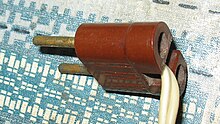
Some appliances sold in the Soviet Union had a flat unearthed plug with an additional pass-through socket on the top, allowing stacked arrangement of plugs. This design was very helpful (for the usual Soviet apartment of the 1960s had very few wall sockets), but somewhat unsafe, as the brass cylinders of the secondary socket were uncovered at the ends (to unscrew them easily), recessed only for 3 mm and provided bad contact because they relied on the secondary plug's bisected expanding pins. The pins of the secondary plug (without insulation sleeves) could not be inserted into the cylinders completely, and were accessible through a 5 mm gap between the primary and secondary plugs.
UK Walsall Gauge plug

Unlike the standard BS 1363 plugs found in the UK, the earth pin is on a horizontal axis and the live and neutral pins on a vertical axis. This style of plug/socket was used by University laboratories (from batteries) and the BBC, and is still in use on parts of the London Underground for 110V AC voltage supply.[citation needed]
Italian Bticino brand Magic security connector
This style of connector, produced by Italian brand Bticino, appeared in the 1960s and was intended as an alternative to the Europlug or CEI 23-16/VII connectors then in use.[45] The socket is an almost rectangular receptacle, with one or more lateral key pins and indentations to prevent inverting the plug (it is polarised), or connecting plugs and sockets with different current ratings. At least four models were produced: three single-phase general purpose connectors rated respectively 10 A, 16 A and 20 A; plus a three-phase industrial connector rated 10 A; all of them have different key-pin positioning so plugs and sockets cannot be mismatched.[46] The socket is closed by a safety lid (bearing the word ‘’Magic’’ on it) which can be opened only with an even pressure on its surface, thus preventing the insertion of objects (except the plug itself) inside the socket. The contacts are blades positioned on both sides of the plug; the plug is energized only when it is inserted fully into the socket.
The obvious drawback of the system is that it is not compatible with Europlugs. As household appliances were never sold fitted with these security plugs and the use of adapters would defeat all of the newly introduced safety features, once this system is adopted all standard plugs must be cut off and replaced with the appropriate security connector. However, the Magic security system had some success at first because its enhanced safety features appealed to customers; standard connectors of the day were considered not safe enough.[45] The decline of the system occurred when safety lids similar to the Magic type were developed (VIMAR Sicury[47]) and then applied to standard sockets by third brands and by Bticino itself.
In Italy, the system was never definitively abandoned and, though rarely seen today, is still marked as available in Bticino’s products catalogue,[48] (except for the three-phase version, that is no longer in production from July 2011)
In Chile, 10 A Magic connectors are commonly used for computer/laboratory power networks, as well as for communications or data equipment. This allows delicate electronics equipment to be connected to an independent circuit breaker, usually including a surge protector or an uninterruptible power supply backup. The different style of plug makes it more difficult for office workers to connect computer equipment to a standard unprotected power line, or to overload the UPS by connecting other office appliances.
In Iceland, Magic plugs were widely used in homes and businesses alongside Europlug and Schuko installations. Their installation in new homes was still quite common even in the late 1980s.
Single phase electric stove plugs and sockets
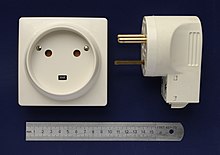
The plugs and sockets used to power electric stoves from a single-phase line have to be rated for greater current values than ones for three-phase system because all the power has to be transferred through a single line. Electric stoves are often hardwired to the electrical supply system, connected to the mains with an appropriate high power industrial connector or with non-standard high power proprietary domestic connector (as some countries do not have wiring regulations for single-phase electric stoves). In Russia an electric stove can often be seen connected with a 25 to 32 A connector.
See also
- AC adapter
- DC connector
- Industrial and multiphase power plugs and sockets
- Mains electricity by country
- Plug load
- Polyphase system
- Stage pin connector
- Two-phase electric power
- IEC Connectors
References
- ^ IEC/TR 60083, Plugs and socket-outlets for domestic and similar general use standardized in member countries of IEC, CH: International Electrotechnical Commission, 2006.
- ^ Collins (2006), "Power Point", Essential English Dictionary (2nd ed.), The Free Dictionary.
- ^ Redesign of a power point socket (e‐publication), SE: Luth, 2001.
- ^ Smart Guide Wiring: step-by-step projects, Fran J. Donegan, Creative Homeowner Press, 2004, p.74 (retrieved 2 February 2012 from Google Books)
- ^ "History". Hubbell. 2009. Retrieved 20 March 2010.
- ^ Witte (1922). "The Automobile Storage Battery Its Care and Repair". Powerstream. Archived from the original on 24 August 2007. Retrieved 14 September 2007.
{{cite web}}: Unknown parameter|deadurl=ignored (|url-status=suggested) (help) - ^ Crist (2005). "Sockets" (tutorial). Mosaic shades. Retrieved 14 September 2007.
- ^ U.S. patent 1,179,728
- ^ German patent number DE 370538
- ^ a b U.S. patent 1,672,067
- ^ http://webstore.iec.ch/preview/info_iecee-cee-7%7Bed2.0%7Db.pdf IEC Webstore preview Retrieved 2011 October 19
- ^ a b c "Electric Current Abroad" (PDF). US Department of Commerce, International Trade Administration. 2002.
- ^ ftp://ftp.cencenelec.eu/CENELEC/TCs/61/PlugsSockets.pdf Plugs and socket-outlet types in each CENELEC country, Retrieved 15 February 2012
- ^ AS/NZS 3112:2004, Approval and test specification — Plugs and socket-outlets, Standards Australia and Standards New Zealand
- ^ "Australian Mains Plug Variants – AS/NZS 3112". Access Communications. 19 April 2007.
- ^ "Mains Plugs with Insulated Pins. Australian Standards AS/NZS3112:2000 & AS/NZS3112:2004 refer [sic]". Access Communications. 19 April 2007.
- ^ BS 1363 (1995), 13 A plugs, socket-outlets and adaptors Specification for rewirable and non-rewirable 13 A fused plugs, British Standards Institute.
- ^ BS 4573 (1970), British Standard Specification for two-pin reversible plugs and shaver socket-outlets, British Standards Institution.
- ^ ГОСТ 7396.1-89 (PDF) (in Russian), RU: Elec.
- ^ Danish Safety Technology Authority
- ^ EN 50075 (1991), Specification for flat non-wirable two-pole plugs 2.5 A 250 V, with cord, for the connection of class II-equipment for household and similar purposes, European Committee for Standardization (CEN).
- ^ 5. udgave af Stærkstrømsbekendtgørelsen afsnit 107-2-D1 "Stikpropper og stikkontakter for danske systemer" (in Danish), DK: Sik.
- ^ BEK nr 1041 af 10/11/2011: Bekendtgørelse om stærkstrømsbekendtgørelsen, afsnit 6C, særlige krav til anvendelse af stikpropper og stikkontakter i installationer (in Danish), DK: Retsinformation
- ^ De Cesco G.: Acqua Luce Gas. Manuali pratici del far da sé. I Jolly bricolage. Fratelli Fabbri Editori, Milano, 1975. PP 70–71.
- ^ De Cesco G.: Acqua Luce Gas. Manuali pratici del far da sé. I Jolly bricolage. Fratelli Fabbri Editori, Milano, 1975. PP 56–57.
- ^ De Cesco G.: Acqua Luce Gas. Manuali pratici del far da sé. I Jolly bricolage. Fratelli Fabbri Editori, Milano, 1975. P 93.
- ^ http://www.vimar.de/de/de/article/article/detail/id/1259
- ^ La ricerca della sicurezza. Ma la ricerca continua (in Italian), EU: Vimar, retrieved 22 January 2009.
- ^ Reference overview from the Swiss Federal Strong Current Inspectorate (Info from the Swiss Federal Administration)
- ^ a b "WA-11A Travel Plug Adapter for Switzerland". Adaptelec.
- ^ "International standardization of electrical plugs and sockets for domestic use". CH: IEC.
- ^ NBR 14136:2002 – Plugues e tomadas para uso doméstico e análogo – Padronização (in Portuguese), BR: ABNT
{{citation}}: Unknown parameter|trans_title=ignored (|trans-title=suggested) (help). - ^ "Norma ABNT NBR 14136:2002" (in Portuguese). BR: Projeto de redes.
- ^ "When Less is More..." ZA: Crab tree.
- ^ "SANS 164 standards: a working group perspective" (PDF). ZA: EE publishers.
- ^ a b WD6, Dimensional requirements for plugs and receptacles (standard), USA: NEMA.
- ^ Child outlet safety, archived from the original on 22 January 2009, retrieved 21 January 2009
{{citation}}: Unknown parameter|deadurl=ignored (|url-status=suggested) (help). - ^ a b JIS C 8303-1993, Plugs and Receptacles for Domestic and Similar General Use, Japanese Standards Association, 1993.
- ^ 内線規程 改訂のポイントの解説ページ Template:Ja-icon
- ^ Thai Industrial Standard 166-2547: Plugs and socket-outlets for household and similar purposes: plugs and socket-outlets with rated voltage not exceeding 250 V (PDF) (in Thai). TH: Thai Industrial Standards Institute. ISBN 974-9815-94-7. Retrieved 23 November 2011.
- ^ USPTO; type in the patent number in the search box, then click "images"
- ^ Terrell Croft, Wiring for Light and Power, McGraw-Hill, 1924, pp. 198–99.
- ^ Oud, Oof. "Wylex plugs and sockets". Digital Museum of Plugs and Sockets. NL. Retrieved 17 December 2011.
- ^ "Miniature Circuit Breakers" (PDF). UK: MK Electric. p. 4. Retrieved 22 April 2010.
- ^ a b De Cesco G.: Acqua Luce Gas. Manuali pratici del far da sé. I Jolly bricolage. Fratelli Fabbri Editori, Milano, 1975. P 73.
- ^ De Cesco G.: Acqua Luce Gas. Manuali pratici del far da sé. I Jolly bricolage. Fratelli Fabbri Editori, Milano, 1975. P 75.
- ^ La ricerca della sicurezza. Il brevetto Sicury www.vimar.eu. Retrieved 12 February 2009.
- ^ Catalogo online. Installazione civile www.professionisti.bticino.it. Retrieved 12 February 2009.
External links
- Glossary of standards terms
- Change to UK electrical wire colors 2004
- Household electrical safety handbook, Electrical and Mechanical Services Department, Hong Kong
- Guidance Notes for the Electrical Products (Safety) Regulation (Electrical and Mechanical Services Department, Hong Kong)
- IEEE history of Australian power connectors (in pdf format)
- South Africa Eskom: Wiring a Plug
- Overviews and diagrams
- Worldwide power plug types — Ningbo Yaosheng Electronic
- Electricity Around The World (about plugs, sockets and electrical systems used around the world)
- Diagrams of Adapter Plugs
- Overview of types of plugs and sockets: pictures including disassembled units
- International Power, Plugs, and Languages
- Power Connection Guidelines for Catalyst 6000 switches — Cisco Systems
- AC Power Cord Illustrations for the Cisco 7600 Series Router — Cisco Systems
- AC Power Cord Specifications for an EX8200 Switch — Juniper Networks






